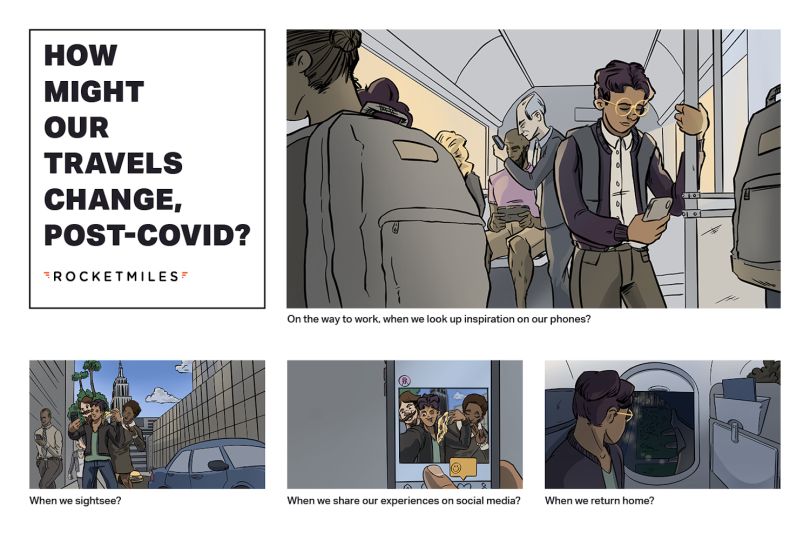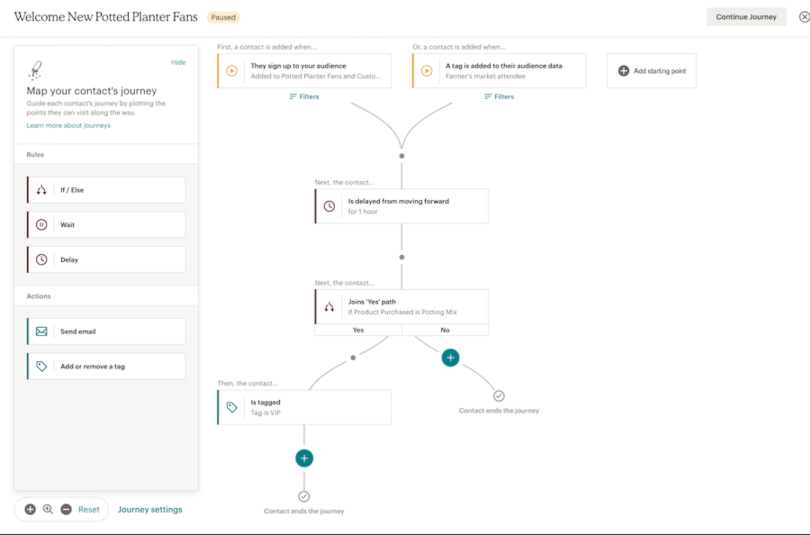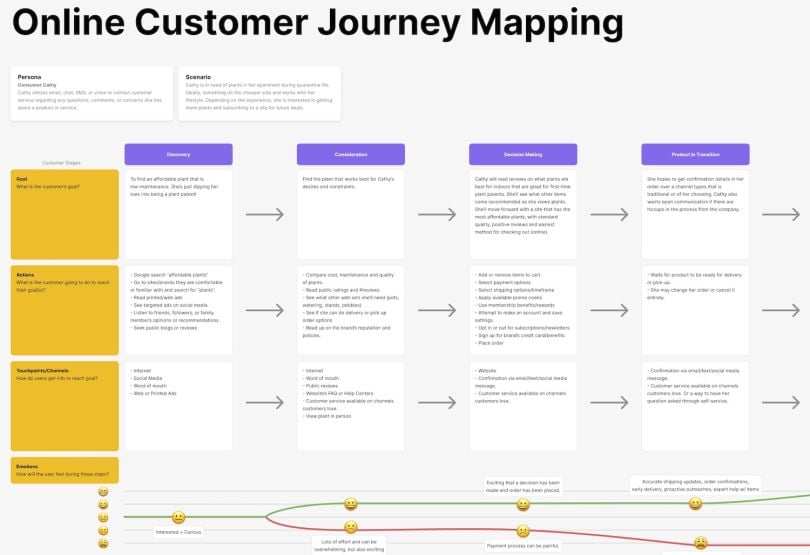Last March, three weeks after Joseph Siwak was hired as an experience designer at the online hotel-booking company Rocket Travel, they sent him home — not with a pink slip, but with a new set of marching orders.
“I went from, literally, being in the middle of a normal traveler journey map to saying, ‘OK, what could the new normal be?’” Siwak said.
For Siwak, an illustrator whose user journey maps resemble artful graphic novels, the arrival of the pandemic meant, among other things, redrawing his vision of the modern traveler’s online experience. And he wasn’t the only one.
“We kind of suspected that people would want more localized safe spaces, like Airbnb and Vrbo, to hang out,” Autumn Schultz, director of experience design at Rocket Travel, said. “So we hypothesized around those ideas and what people might want to do in that space as well.”
User Journey Mapping Do’s
- Clarify your goals.
- Consider the scope.
- Gather a multidisciplinary team.
- Validate assumptions with analytics.
- Validate assumptions with interviews of loyal users.
- Start the journey prior to the customer’s discovery of your product.
- Differentiate new and existing customers.
- Match the fidelity of the map to its goals.
- Weave in real-life artifacts.
- Sync your in-app messaging with user journey flows.
These conversations led to a new journey map plotting users’ experiences on Rocketmiles, the company’s signature hotel booking app. Cartoon personas took on new expressions of anxiety. Once concerned over hotel prices, travelers were now frightened at the prospect of going, basically, anywhere. The map suggested where in-app messaging at key touchpoints could help address user concerns.
Turns out, user journey maps serve many functions. They help internal teams empathize with user needs. They clarify where and how features or engagements should surface in a digital product. They contextualize how a product or offering stacks up to a competitor’s.
“It’s a tool to generate ideas, to get people in a room and have real discussions, strategically, about what we want to address and when.”
Whether created on physical whiteboards or the digital boards of companies like Miro, Figma, Confluence or Lucidchart, journey maps offer a high-level view of a customer’s experience that sheds light on how they feel as they navigate the product.
“It’s a tool to generate ideas, to get people in a room and have real discussions, strategically, about what we want to address and when. Not every pain point is the worst pain point and not every opportunity is a happy path,” Siwak said.
Here, executives and product leaders reveal what to do — and what not to do — to make the exercise worthwhile.
Clarify Your Goals
“All good journey maps have a goal in mind,” said Keith Mancuso, a technical product manager at the digital agency Happy Cog. “You might want to increase utilization of discounts, increase average order value or increase page views.”
At Fueled, a New York-headquartered web and app development consultancy, journey mapping serves a two-fold purpose, Derek Burgess, the lead product manager, said. For existing clients like MGM Resorts International, Verizon and Warby Parker, journey mapping guides the development of new or existing products or services. For prospective clients, Fueled uses journey maps to plan and execute pitches.
“Any time a designer kicks off a project like this, it’s really important to describe why you’re doing it and what we should expect.”
“We do communications-strategy deliverables and growth-strategy deliverables. And with both of them, we use the user journey map to target areas that may be inefficient,” Burgess said.
Often, the goal is to rally support for a feature release among internal teams.
“Any time a designer kicks off a project like this, it’s really important to describe why you’re doing it and what we should expect,” Schultz said. “[Designers] all get really excited about doing these things, but if your partners — whether that’s your product people, engineers, CEO, operations or customer service people — don’t know why you’re doing it, it feels untethered.”
Consider the Scope
Matthew Hardesty is vice president of product at Brainbase, a platform that helps organizations like BuzzFeed and the Van Gogh Museum manage their intellectual property. He said his team generally spends no more than a week on a journey map. However, the time allotted reflects the breadth of the tasks being mapped.
A map might span the entire product lifecycle or a single engagement, such as the registration flow. The scope of the map should reflect the projected value of the product or proposed changes.
“You want to understand the tradeoffs, whether they are monetary or based on strategic reasons,” Hardesty said. “We know conversion rates are each worth X dollars. We think these improvements will increase the value by X amount and affect this many users.”
Gather a Multidisciplinary Team
Schultz recommends gathering a multi-disciplinary team early on to co-create the user journey map.
“So, not just design, but maybe it’s operations, maybe it’s customer service, maybe it’s a product person,” she said. “You could do this as a workshop, you can start mapping Post-Its from, say, the moment people start thinking about an experience to when they start looking for solutions to their problem or whatever they’re trying to achieve.”
Validate Assumptions With Analytics
Journey maps tend to be chock full of assumptions. One way to validate these is through behavioral analytics platforms like FullStory, Hotjar and Amplitude that offer reports, performance graphs and session replays to evaluate user engagement.
“With tools like FullStory, you can basically watch user sessions,” Hardesty said. “Press play and see exactly what they did. It’s not just analytics or a heat map, but how far they scrolled down a landing page, where they are in the viewport, what they’re looking at and whether they’re converting.”
Validate Assumptions Through Interviews With Loyal Users
Hard data helps validate assumptions, but qualitative interviews with longtime customers are often just as valuable.
“If they’re a repeat customer, and you’re trying to understand lifetime value, you can’t outsource that all that easily,” Schultz said. “One thing I think is super interesting is if you can get actual videos of your customers — if they’re willing to be recorded. Because tying an emotional hook to the experience is a lot more compelling for an engineer, or someone who is pretty far from the customer experience. It’s a way for them to understand, ‘This is why we’re doing it.’”
Conversations can happen informally, Siwak said, via a Zoom call with a customer who has opted in to provide input on a beta release, or a shared Slack channel where a peer from another company may be able to provide useful insights. Companies like dscout and UserTesting also offer remote user testing services.

Start the Journey Prior to the Customer’s Discovery of Your Product
A user journey map doesn’t have to start inside your product — it can start in the mind of a prospective user, Siwak said. Take the journey of a would-be traveler on Rocketmiles: “You’re sitting at work one day, and you’re just daydreaming of doing something different,” he said. “That’s a great jumping-off point for thinking about [the journey map].”
Envisioning the user’s journey holistically, beginning even prior to discovery, can lead to unexpected insights.
“People are discovering things [during the pandemic] maybe they wouldn’t have in a normal life and doing things differently — learning to ski all of a sudden,” Siwak added. “I have a friend who’s living near Yellowstone and trying to become an influencer with some buffalo.”
Differentiate Between New and Existing Customers
Within a journey map, design patterns often follow a typical chronology and tree logic. At registration, for instance, a visitor might be asked to sign up or continue as a guest. Assuming they sign up, a subsequent message asks for permission to send notifications. Later, they might be asked if they’d like to share their location.
But it’s important to differentiate the journeys of new and long-time users, Burgess told me.
In a mapping project for an insurance company offering supplemental employee benefits and discounts, Fueled plotted two distinct journeys — one for new employees enrolling shortly after being hired, and a second for established employees casually shopping online.
New employees received the promotions as an upgrade offer when they enrolled for standard benefits packages. For the second group, a pre-installed Chrome extension embedded in the insurance platform promoted discount codes at optimized intervals.
Match the Fidelity of the Map to Its Goals
The fidelity of a map should match its goals. Rocket Travel uses low-fidelity journey mapping to explore how potential Rocketmile customers use rival services such as Expedia, TripAdvisor — even Google — to plan for travel.
“I often will start with a lower-fidelity user journey with lots of assumptions on it,” Siwak said. “And just put a giant watermark that says, ‘These are all assumptions.’ And then, as we validate things, I’ll increase the fidelity — make it feel like we’ve talked to people about this, we know that it’s true.”
“I often will start with a lower-fidelity user journey with lots of assumptions on it, and just put a giant watermark that says, ‘These are all assumptions.’”
As a journey map becomes more refined, Siwak sharpens the imagery to create a dramatic narrative that accentuates pain points and happy moments along the user’s journey.
“I’ll try to make them almost like a comic,” he said. “Because I want people to be excited by the map and feel like it’s something they want to look at. The online [templates] are usually just so dry. If it’s all text, people will not want to read it.”
Weave in Real-Life Artifacts
Digital artifacts or “bread crumbs” — such as links to competitors’ sites, video or audio recordings of customer interviews, surveys and key research findings — are another way to create an emotional hook. Want to strengthen your case for adding a new feature? Try adding a snapshot of what’s possible.
For example: “We might include a picture of a Google spreadsheet of a user’s hotel options,” Schultz said. “It’s very true that customers create these to manage their reservations and share with their friends. Clearly, there’s a pain point in the travel experience that we’re not addressing and no one else has actually addressed, and that’s an opportunity. People have developed their own hacks. How do you lean into those hacks?”

Sync Your In-App Messaging With User Journey Flows
Platforms like Intercom, HubSpot and Braze now include custom journey builders designers can use to map the delivery of announcements, product tours, feature highlights and call-outs. These automated messaging services have become quite sophisticated in recent years, Burgess said.
“It’s almost like a CMS,” he explained. “You can use [the tools] to set up the structure for when a message triggers and how it triggers, and you can even set goals. It will report back to you the open rate and where people dropped off.”
User Journey Mapping Don'ts
- Don’t build journey maps from customer support tickets.
- Don’t limit your journey to the product funnel.
- Don’t over-index your map.
- Don’t forget your internal users and administrators.
- Don't wait to consult with other teams.
- Don’t create too many personas.
- Don’t ignore your non-users.
- Don’t do journey mapping in a vacuum.
- Don’t act on every customer suggestion.
Don’t Build Journey Maps From Customer Support Tickets
Joseph Ansanelli is CEO and co-founder of Gladly, a company that helps consumer brands like Crate & Barrel, Porsche and Ralph Lauren provide customer service through a multi-channel platform. He said journey maps that scope a customer’s experience across a single support ticket, rather than their entire history with a brand, miss the mark.
“We come at this from a standpoint of questioning how everyone else is doing journey mapping,” Ansanelli said. “The historical model is to create a journey based on a support ticket. That’s the wrong journey.”
“The historical model is to create a journey based on a support ticket. That’s the wrong journey.”
Instead, Ansanelli said interactions across channels — web browsers, in-app chat services, social media and live phone calls with customer-support agents — should be treated as a single journey.
“The right journey is when a customer contacts you, and you get them to the best person to help. It’s part of one lifelong conversation,” he said. “Otherwise, anytime a problem arises, you have to create another journey and another ticket, which requires two different support people to manage. That’s a broken system.”
Don’t Limit Your Journey to the Product Funnel
Conceptualizing the user journey as a funnel can make sense from a business standpoint, but that model has limitations.
“People don’t live in a funnel, they bounce around,” Schultz said. “Things are not constant. Journeys aren’t linear.”
Instead, journey maps should approach the product experience from a customer’s perspective. Stages in the journey such as discovery, onboarding, experimentation and habit-building should track the user’s evolving attitudes and reasoning.
“When you talk about funnels, it’s very hard to wear both hats,” Schultz said. “You’re looking at it from like a purely quantitative perspective — again, not wrong, just a different type of framework. Whereas journey mapping is meant to deepen your empathy and generate ideas.”
Don’t Over-Index Your Map
It’s easy to get bogged down in minutiae that mean little to customer satisfaction, much less the bottom line. Unless you’re a designer at a huge company like Amazon, where you might be called on to work toward infinitesimal improvements of a nano-feature, your focus should be on prioritizing what’s really important.
“What percent confidence are you adding by knowing a user scrolled 5 percent more on a page?” Hardesty asked. “Unless it’s your landing page, who cares? It’s not meaningful information.”
A better route, he told me, is to use a prioritization framework, such as the Kano model, to determine which features are most likely to resonate with customers. As he put it: “Do we think this will be a big winner? Is the juice worth the squeeze?”
Don’t Forget Internal Users and Administrators
Too many companies consider the journeys of their end-users, but not the internal teams supporting the software.
Recently, Happy Cog consulted on a web design and development refresh for Posse, a non-profit organization that awards scholarships to groups of first-generation college students. The site offers several touchpoints to guide students through the nomination and selection process.
However, the support that students receive from mentors once they attend college is equally important to the program’s success. Are they maintaining good grades? Are they attending organizational meetings? These factors needed to be better addressed in the design, Mancuso said.
“Posse, for the longest time, only focused on what student nominees see. But the internal audience has a journey as well, through more complicated content management systems that allow mentors to post news, update marketing features and check in on students,” he said.
Don’t Wait to Consult With Other Teams
Another way to torpedo a journey map is by waiting too long to invite key stakeholders.
“The more you wait, the more folks might feel surprised or question your findings,” Siwak said. “When people feel like they’re discovering it with you, there’s a lot less pushback. No one likes the surprise of hearing, ‘Hey, whatever part of the journey you’re responsible for sucks.’”
Beyond that, the journey mapping exercise can build solidarity for new product initiatives.
“I’ve never had anyone be like, ‘I think it was a waste of time,’” Siwak said. “And even if nothing scandalous is discovered in an ideation session, most people just enjoyed doing something different with their day.”

Don’t Create Too Many Personas
On the surface, separating personas by demographics — for instance, women in their 40s and men in their 20s — might seem like a good way to get an accurate view of your customer cohorts. But you can quickly lose the forest for the trees.
“Creating too many personas divides the audience too much,” Mancuso told me. “The journey becomes too complicated because there’s too much noise.”
Keep it simple: three to five personas.
Don’t Ignore Your Non-Users
What does this mean at a hotel-booking site like Rocketmiles?
“You have travelers who will never use the internet,” Siwak said. “Like the person on a road trip. You hit a rest stop in Tennessee, and there are those little pamphlets, and maybe you’re like, ‘You know what, I am going to go check out Dollywood today.’ Knowing that happens in the world might give us an opportunity, in the future, to capture a new market.”
Don’t Do Journey Mapping in a Vacuum
Talking to real customers to understand their attitudes toward your product, as well as those of competitors, is crucial to journey mapping. But companies often shortchange this part of the process.
“You get small companies that say, ‘We don’t have a lot of resources and money and time, and we’ve made this decision and we’re going to go with it.’ Or big companies that think they know everything about their customers,” Hardesty said.
Both views are distorted.
“Every time you come up with a feature idea, go back to the journey map, go back to your highest-grossing customers, your champions. At previous companies, I’ve helped establish customer advisor boards — a set of industry experts you can go to to gut check your assumptions.”
Don’t Act on Every Customer Suggestion
When several customers point to a particular bug or feature flaw, that’s a good signal that it’s time to revisit the journey map. However, while customers are good at seeing what’s broken, they’re less adept at positing solutions.
For example, if a customer requested a better way to search, sort and filter information: “You have to take these things with a grain of salt,” Hardesty said. “Maybe we create a different page, or reassign some of the content, and take care of 90 percent of what the individual user needs.”




